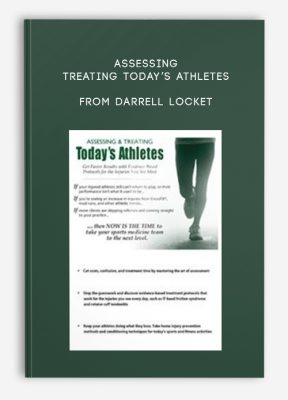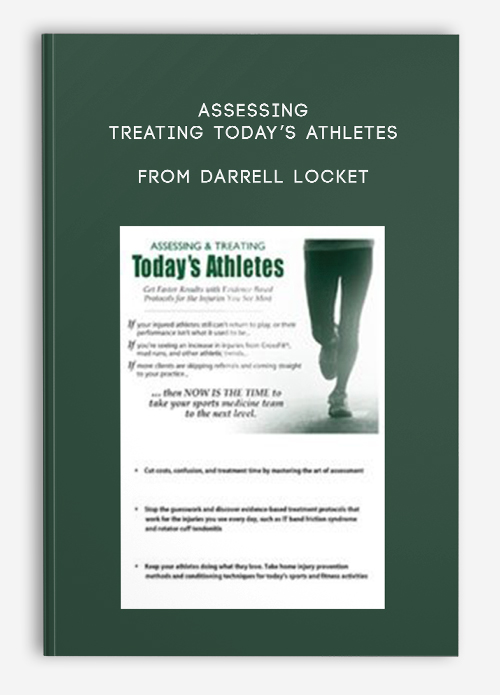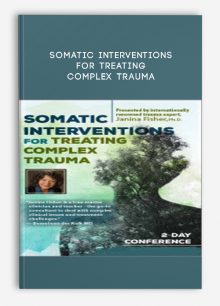Assessing, Treating Today’s Athletes from Darrell Locket
$109.00 $32.00

Assessing, Treating Today’s Athletes Get Faster Results with Evidence-based Protocols for the Injuries You See Most from Darrell Locket
Faculty:Darrell Locket
Duration:6 Hours 11 Minutes | Format:Audio and Video
Archive : Assessing, Treating Today’s Athletes from Darrell Locket
Get Assessing, Treating Today’s Athletes from Darrell Locket on Salaedu.com
Outline:
Sports Medicine Team Practitioner Approach to Treatment of Sports Injuries
- Treatment of the injury: Non-operative and operative (types of surgery)
- Healing phases and rehabilitation
- Lab: Comprehensive sports injury physical examination
- Lab: Gait, posture, and functional kinetic chain assessment
LAB: Physical Examination of the Ankle & Lower Leg
- Preventive measures, mechanics of injuries, inspection of gait, range of motion, manual muscle testing, and special stress tests
- Pes anserinus bursitis or tendonitis
- Shin splint or medial tibial stress syndrome
- Posterior tibial tendon dysfunction
- Achilles tear, strain, bursitis, tendonitis, or tenosynovitis
- Gastrocnemius and soleus strain
- Retrocalcaneal bursitis or Sever’s syndrome
- Lateral and medial ankle sprain
- Syndesmotic injuries (high ankle sprain)
- Tarsal tunnel
- Interdigital (Morton’s) neuroma
- Plantar fasciitis
- Peroneal tendon subluxation
- Jones fracture
- Stress fracture
- Avulsion fractures
LAB: Physical Examination of the Knee, Hip, & Thigh
- Preventive measures, inspection of gait, squats, lunges, range of motion, mechanics of injuries, palpation, and special stress tests
- Ligament injuries
- Anterior and posterior cruciate
- Medial and lateral collateral
- Cartilage injuries
- Meniscal tears
- Articular
- Degenerative joint disease
- Ligament injuries
- Patellafemoral injuries
- Chondromalacia
- Malalignment and instability
- Tendonitis or Osgood-Schlatter
- Degenerative joint disease
- Muscle injuries
- Gluteus maximus weakness
- Gluteus medius and minimus weakness
- Tensor fascia lata weakness
- Quadriceps femoris and hamstring strain/tendonitis/ruptures
- Hip injuries
- Hip impingement
- Trochanteric bursitis
- Adductor strain
- Iliotibial band friction syndrome
LAB: Physical Examination of the Shoulder & Arm Injuries
- Preventive measures, inspection posture, functional movement, mechanics of injuries, range of motion, palpation, and special stress tests
- Glenohumeral instability, anterior or posterior joint
- Rotator cuff strain, impingement or tendonitis
- Pectoralis strain
- Acromioclavicular joint sprain
- Brachial plexus (burner/stinger)
- SLAP lesion
- Bicipital tenosynovitis/subluxation
- Triceps and biceps strain
- Bursitis of elbow
- Lateral and medial epicondylitis of the elbow
LAB: Physical Examination of the Back Injuries
- Preventive measures, inspection gait, posture, functional kinetic chain assessment, mechanics of injuries, range of motion, palpation, and special stress tests
- Piriformis syndrome and sciatica
- Erector spinae muscle strain
- Sacroiliac sprain
- Acute and chronic low back pain
- Lumbar spinal stenosis
LAB: Physical Examination of the Wrist, & Hand Anatomy
- Preventive measures, inspection posture, mechanics of injuries, range of motion, palpation, and special stress tests
- Trifibrocartilage (TFC)
- DeQuervain’s
- Hand and fingers fracture/other conditions
- Gamekeeper’s thumb
*This course content is not intended for the use by participants outside their scope of practice regarding their state licenses, national certification, or regulation.
Get Assessing, Treating Today’s Athletes from Darrell Locket on Salaedu.com
Description:
Why Some Injured Athletes Never Return to Play—and What You Can Do About It
Whether they’re wrecking themselves in CrossFit® or football, record numbers of weekend warriors are cropping up with the sports injuries of professional athletes. That means business is booming for rehab professionals like you. However, with more athletes skipping physicians than ever before, you’ve got to be confident in your assessment skills if you hope to treat symptoms at their source. If your caseload has stalled during this busy time with patients who aren’t making much progress, now’s the time to reevaluate your evaluations.
This hands-on program will take your sports medicine team to the next level, equipping you with evidence-based, multidisciplinary protocols for the athletic injuries you see most. From IT bands to impinged rotator cuffs, this course provides efficient clinical pathways for each member of your team, eliminating the guesswork from assessment, evaluation, treatment, and rehabilitation. With plenty of practice throughout the day, you’ll quickly grasp the “why,” “what,” and “how” of common conditions like acute/chronic inflammation, microtrauma, neuromuscular imbalances, and joint instability. The effective interventions you’ll try out in class will feel like second nature by the time you return to work.
Finally, explore the unique biomechanical demands of common sports and fitness activities and take home injury prevention methods and conditioning techniques that keep your clients doing what they love, whether they’re swinging golf clubs or kettlebells.
1 review for Assessing, Treating Today’s Athletes from Darrell Locket
Add a review Cancel reply
Related products
HEALTH - FITNESS - LIFESTYLE - MEDICAL
Fast Confidence [How To Be More Confident │Confidence Building] from Sharon Melnick, Ph.D.
HEALTH - FITNESS - LIFESTYLE - MEDICAL
HEALTH - FITNESS - LIFESTYLE - MEDICAL
Complete Certified Professional Coach Online Course from Berry Fowler
HEALTH - FITNESS - LIFESTYLE - MEDICAL
Somatic Interventions for Treating Complex Trauma with Janina Fisher, Ph.D. from Janina Fisher
HEALTH - FITNESS - LIFESTYLE - MEDICAL
HEALTH - FITNESS - LIFESTYLE - MEDICAL
HEALTH - FITNESS - LIFESTYLE - MEDICAL


![Fast Confidence [How To Be More Confident │Confidence Building] from Sharon Melnick, Ph.D.](https://tradersoffer.forex/wp-content/uploads/2017/05/Sharon-Melnick-Ph.D.-Fast-Confidence-How-To-Be-More-Confident-│Confidence-Building-220x261.png)







king –
Rose W
“Love Darrell Locket. Have taken many of his courses. Wish I could mentor with him for a few months!”